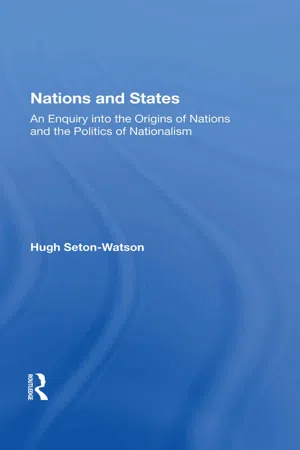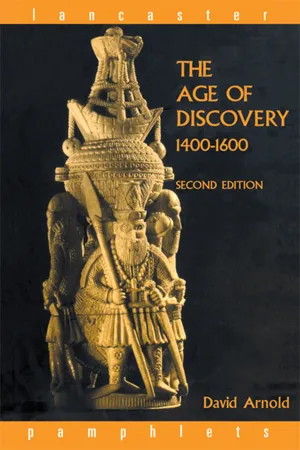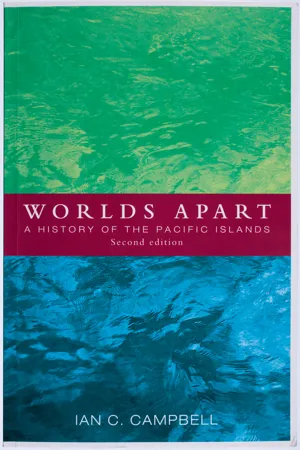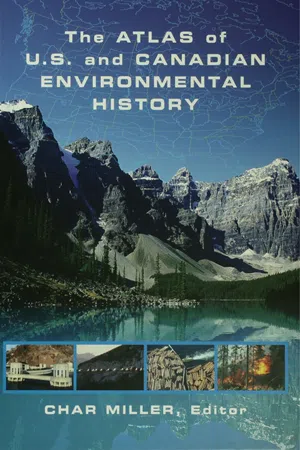History
European Explorers
European explorers were individuals from Europe who embarked on voyages of discovery and exploration during the Age of Discovery from the 15th to 17th centuries. They sought new trade routes, resources, and territories, leading to the expansion of European influence around the world. Notable explorers include Christopher Columbus, Vasco da Gama, Ferdinand Magellan, and Hernán Cortés.
Written by Perlego with AI-assistance
Related key terms
5 Key excerpts on "European Explorers"
- eBook - ePub
Nations And States
An Enquiry Into The Origins Of Nations And The Politics Of Nationalism
- Hugh Seton-watson(Author)
- 2019(Publication Date)
- Routledge(Publisher)
5European Nations OverseasThe expansion of EuropeThe great voyages of exploration at the end of the fifteenth century, round the coast of Africa and out into the Atlantic, were made possible by new methods of shipbuilding and of navigation, pioneered by the Portuguese. The Atlantic, no longer the Mediterranean, became the main route for the movement of men, commerce and political power. The explorers, and the rulers who sponsored their voyages, had various motives: to win individual fame, to grab wealth, to glorify a particular monarch, to search for distant eastern allies against the Ottoman threat, and to convert the heathen to the true faith. This tremendous outburst of navigating skill, commercial greed and military aggression also coincided with the outbreak of the Reformation. The expansion of European Christian power over the world went together with the warring of Christians against each other, in the name of their faith. One of the consequences of the religious conflict was the emigration of defeated religious communities to the new world of North America, to build there a new society.The expansion flowed in two directions, with very different results. The Portuguese, followed by the Dutch, the French and the English, discovered the great civilisations of the Far East, of which they had heard dim rumours for centuries past: and in time they imposed their rule on large tracts of Asia. There were never, however, many Europeans settled in these lands; and the civilisations of India, China, Japan and the Archipelago, though modified by contact with Europeans, remained essentially unchanged.Those who ventured across the Atlantic, above all the Spaniards, discovered continents of which nothing had ever been known, and communities ranging from the primitive to the highly sophisticated, all far more different from their own than were those of Asia. Having subdued these communities, the European invaders set themselves to create New Spain, New France and New England. - eBook - ePub
- Cynthia Metcalf, Rhonda Atkinson, Rhonda Atkinson(Authors)
- 2017(Publication Date)
- Research & Education Association(Publisher)
CHAPTER 5 U.S. HistoryCOMPETENCY 5.1Evaluate the impact of the Age of Exploration on the Americas.Although the Vikings had arrived in North America approximately 500 years earlier, the Age of Exploration describes a time in which Europe first “discovered” and explored the new world. Governments supported such activity in order to gain wealth and to preempt other countries. Explorers were often motivated by one or more of the three Gs: God, Gold, or Glory. This era is marked by three phases: discovery, preliminary exploration, and expansion as Europeans migrated to the Americas. Spain, Portugal, England, and France played the greatest roles in this age.Spanish and Portuguese BeginningsItalian explorer Christopher Columbus believed he could find a route to the East by sailing West. He asked for support from the King of Portugal, cities in Italy, and the King of Spain without success. Finally, King Ferdinand of Spain changed his mind and in 1492, sponsored the voyage in which Columbus discovered the “New World” of the Americas. With the support of the Spanish king, Columbus made three additional trips to the Americas where he explored islands in the Caribbean and finally landed on the mainland of South America. On one of his return voyages to Spain, Columbus stopped in Portugal and described what he had found to Portuguese King John II, who was also interested in exploring and claiming territories in the new world. In an effort to settle a dispute between the Spanish and the Portuguese over who should get which territory, Pope Alexander VI (a Spaniard, actually) set up a Line of Demarcation that would separate the territories of the world between the two largest Catholic powers, the Spanish and the Portuguese. This was the Treaty of Tordesillas. - eBook - ePub
- David Arnold(Author)
- 2013(Publication Date)
- Routledge(Publisher)
Part One The Meaning of ‘Discovery’ It could be argued that there have been many ‘ages of discovery’ in history, involving many different peoples and civilizations, and that it is inappropriate to single out this period as being the Age of Discovery. Equally, it could be questioned whether this was anything more than an age of European exploration and aggrandisement, a phase in the history of the West that left many other societies around the world relatively unaffected. It is hard, however, to doubt the overall significance of this period, by whatever name we call it. Though the era of maritime expansion could be pushed back to AD 800 to include the early voyages of the Vikings or carried forward into the seventeenth and eighteenth centuries when Europe gained a wealth of new knowledge about areas of the globe hitherto little investigated (such as the South Pacific and Australasia or the vast interior regions of Africa, Asia and North America), the essential geographical discoveries, including the exploration of the West African coast, the discovery of the ‘New World’ and the Cape route to the Indies, and the first circumnavigation of the globe, were all made between the early fifteenth and mid-sixteenth centuries. Writers as diverse in their opinions as Adam Smith in The Wealth of Nations in 1776 and Karl Marx and Frederick Engels in the Communist Manifesto of 1848 saw the discovery of America and the rounding of the Cape as among the principal events in history and as laying the basis, economically and politically, for the modern world. Many recent historians have endorsed this view and provided fresh evidence for the foundational importance of the Age of Discovery. In this remarkably short period, Europeans acquired an unparalleled knowledge of the rest of the world - eBook - ePub
Worlds Apart
A History of the Pacific Islands
- Ian C. Campbell(Author)
- 2016(Publication Date)
- Canterbury University Press(Publisher)
CHAPTER THREEThe Age of European DiscoveryT HERE IS NO sharp break between pre-European and European Pacific history. The coming of Europeans was sporadic, intermittent and protracted; it varied immensely in intensity and character. Meanwhile, Pacific islanders went about their affairs according to their normal mode of life: indigenous history-making did not cease, but it did begin to be recorded in writing, albeit unevenly and incompletely.European exploration of the Pacific was undertaken for complicated reasons, not for any single one. Indeed the word ‘exploration’, implying deliberate, systematic investigation, is itself misapplied to much of the process because many discoveries were simply incidental to the main purpose of the various voyagers. These multifarious purposes are part of the history of Europe since Renaissance times, when political, economic and intellectual ferment encouraged Europeans to go out into the wider world of which hitherto they had occupied only the fringe.Spanish beginnings
At the end of the 15th century the Spanish discovered the New World of the Americas across the Atlantic and began to exploit its wealth; and Portugal had found the sea route to India by circumnavigating Africa. Between these two events, the Spanish and Portuguese had agreed to a division of their interests in the world by the Treaty of Tordesillas in 1494. Spain claimed the western hemisphere, and Portugal the eastern. Within less than 20 years the Portuguese had a chain of trading posts or bases at strategic places in the Indian Ocean and as far as Canton in China. Lucrative though their American possessions were, the Spanish resented being shut out of Asian trade and a dispute arose as to where the Asian extension of the line of demarcation between these two powers fell.In 1521 Ferdinand Magellan became the first navigator to cross the Pacific, in a successful attempt to show that Spain could access Asia without traversing the prohibited Indian Ocean. In other respects, Magellan’s expedition was disastrous, not least because the distance involved made the journey virtually suicidal. Spain’s future expeditions across the Pacific to Asia therefore set out from the newly acquired territory on the west coast of Mexico. There were two more in the 1520s, another in 1542, and finally, in 1564, an expedition was sent to establish a colony. Thus began the Spanish conquest of the Philippine Islands, and with it the inauguration of an annual voyage of a treasure galleon, the first regular traffic across the Pacific. The Spanish stumbled on other islands in the course of these voyages, in the Marshall and Mariana Islands, and later among the Caroline and Gilbert Islands, but it was only in Guam that they showed any interest, regarding it as a place of refreshment towards the end of the long voyage from Mexico to Manila. The hope of plundering Spanish treasure brought English predators into the Pacific. Francis Drake circumnavigated the globe in 1577–80, and in 1588 he was followed by Thomas Cavendish. These piratical adventures added nothing to European knowledge of the ocean or its islands. - Char Miller(Author)
- 2003(Publication Date)
- Routledge(Publisher)
While the explorers provided first-hand accounts of the territory and the continent’s rich resources, cartographers in Europe painstakingly pieced together a jigsaw of geographical information, converting this mythic region into a tangible territory read to be settled and exploited. Thus began the transformation of a romantic and bountiful wilderness into a rapidly populated and commercially important continent. Early Explorations. A handful of Europeans have been credited for what was, in reality, the collective effort of thousands of explorers, cartographers, missionaries, traders, and land speculators. Credit for discovering the New World is popularly given to Italian-born mariner Christopher Columbus, whose four voyages across the Atlantic Ocean between 1492 and 1504, under the sponsorship of the Spanish monarchy, began the European conquest of the Americas. Claims that Italian navigator Amerigo Vespucci reached the mainland first are generally disputed by scholars, but Vespucci is credited as the namesake of “America” and with charting much of the northern coast of South America. Neither Columbus nor Vespucci was the first European to reach North America: Icelandic explorer Leif Ericson is believed to have reached the coast of Labrador in about 1000 A.D Columbus’s explorations led to Spain’s domination of the southern part of the North American continent during the 1500s (see also 16–17); other explorers, including John Cabot, explored the north. Cabot was an Italian navigator sailing under the mandate of England’s King Henry VII “to seeke out, discouer, and finde whatsoever isles, countreys, regions or prouinces of the heathen and infidels whatsoeuer they be, and in what part of the world soeuer they be.” When he reached the North American mainland in 1497, Cabot established England’s claim to the entire northern continent. The claim to such a vast area was tenuous, not least because French and Dutch mariners were also actively exploring the region
Index pages curate the most relevant extracts from our library of academic textbooks. They’ve been created using an in-house natural language model (NLM), each adding context and meaning to key research topics.




